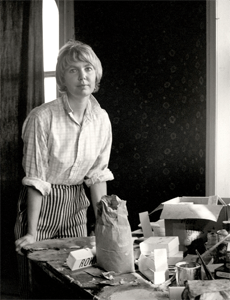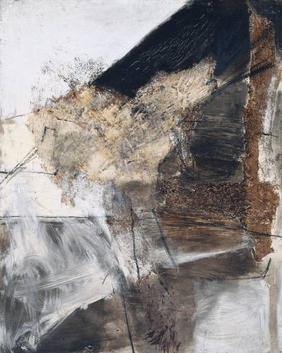Sandra Blow facts for kids
Quick facts for kids
Sandra Blow
|
|
|---|---|

Sandra Blow in 1955, photo by Ida Kar
|
|
| Born |
Sandra Betty Blow
14 September 1925 London, England
|
| Died | 22 August 2006 (aged 80) Truro, England
|
| Occupation | Artist |
Sandra Betty Blow RA (born September 14, 1925 – died August 22, 2006) was a famous English artist. She was known for her abstract paintings and was a key figure in the British abstract art movement of the 1950s. Sandra Blow created large, colorful artworks using everyday, discarded materials. She often made collages, which are artworks made by gluing different materials onto a surface.
Sandra was born in London. As a child, she had scarlet fever. She spent her weekends and holidays at her grandparents' fruit farm in Kent, where she loved to paint. She later studied art at Saint Martin's School of Art and the Royal Academy of Arts. She also studied in Rome, Italy, where she met fellow artist Alberto Burri. They traveled and worked together, and Burri's style greatly influenced her art.
Contents
Sandra Blow's Early Life and Art Training
Sandra Betty Blow was born on September 14, 1925, in Newington, London. Her family was Jewish, and her father was a fruit wholesaler. Sandra was the second of three children. She spent many happy weekends and holidays at her grandparents' fruit farm in Kent.
In 1934, Sandra became very ill with scarlet fever. This was followed by rheumatic fever, which affected her heart for the rest of her life. After attending a local primary school, she went to a private girls' school. When she was 14, Sandra, her mother, and her brothers moved to Paddock Wood in Kent. This was close to her grandparents' farm, and she spent her time reading, drawing, and painting.
After leaving school at 14, Sandra started studying at Saint Martin's School of Art in 1941. She stayed there until 1946, learning from teachers like Ruskin Spear. During this time, she met many other artists, including Lucian Freud and Francis Bacon. In 1947, she briefly attended the Royal Academy of Arts schools. However, she found the teaching boring and decided to travel to Italy to study classic art.
In Italy, she was inspired by Nicolas Carone to join the Accademia di Belle Arti in Rome. There, she met Alberto Burri, an artist who would influence her work for many years. They traveled together in Italy in 1948.
Sandra Blow's Career and Success
After Italy, Sandra Blow traveled through Spain and France. She and Alberto Burri worked together in Paris in 1949. However, Sandra felt Burri's influence was too strong, so she returned to the UK in 1950. She wanted to develop her own unique style. Even though they worked separately, Sandra and Burri continued to inspire each other's art throughout the 1950s and 1960s.
In the 1950s, it was challenging for women artists to become famous, especially if they painted abstract art. Sandra Blow worked hard to make a name for herself. A big moment in her career was when Roland Penrose, who helped start the Institute of Contemporary Arts, bought one of her first artworks.
Sandra's career grew even more when a major London art gallery, Gimpel Fils, started showing her work in 1951. This gallery helped her have regular exhibitions and even her first solo show in New York. Gimpel Fils also represented artists from St Ives, a coastal town in Britain. This connection led to Sandra's lifelong love for St Ives. In 1957, she lived there for a year and later moved there permanently.
In 1961, Sandra Blow began teaching painting at the Royal College of Art. She taught there until 1975 and was even made an honorary fellow. While teaching, she also continued to paint in her studio in Chelsea, London. In 1978, she was elected to the Royal Academy of Arts, which is a great honor for an artist.
Sandra Blow's Unique Artwork

After her art training, Sandra Blow was influenced by Nicolas Carone's ideas about color and space. She was also greatly influenced by Alberto Burri, who used unusual materials like old sacks in his abstract art. Sandra and Burri's relationship helped them inspire each other's artistic styles. Through Burri, Sandra started using "poor" or non-traditional materials in her art. For example, in her painting Space And Matter, she used liquid cement, chaff (husks of grain), and charcoal. Burri's biggest influence was his strong dedication to art and his interest in different textures.
Sandra Blow's art was at the forefront of the British abstract art movement in the 1950s. She was one of the most original women painters in Britain. Her works often focused on surface textures, making them feel real and touchable. She usually used simple, large geometric shapes. Sandra often used collage techniques in her paintings. In her early works, she sometimes dyed her canvas with tea to create natural colors. Her later paintings showed more color and even simpler geometric forms.
One famous artwork by Sandra Blow is Space And Matter (1959). It's an oil painting on board, but she added other experimental materials. This made the painting look like wood, tar, flames, and even sea spray. In the 1970s, Sandra worked with an architect named Eric Defty. This collaboration led her to add geometric shapes to her art and use more square canvases, like building blocks.
Sandra Blow's art was shown in many places during her life. Her works were bought by important museums like the Museum of Modern Art and the Tate. She also showed her art at the 1958 Venice Biennale and won the 1960 Guggenheim International Award. Her work was also displayed at the Victoria and Albert Museum. Even after moving to St Ives in the 1990s, she continued to work in London. She participated in the Royal Academy's Summer Exhibitions and had a special exhibition of her work in 1994.
In 1995, she created her only large artwork using glass. It was an illuminated glass screen called Flight Structure. This artwork was installed in Heathrow Terminal 3 at Heathrow Airport. It was placed near the entrance where people go through security to board their flights. Sandra designed it to show the feeling of moving from security to flight. It has since been moved to the airport's main office. From 2001 to 2002, an exhibition of her work at Tate St Ives was named Space and Matter, after her famous painting.
Sandra Blow's Later Life
Sandra Blow lived in a flat in South Kensington, London, since the 1960s. However, she had to move because the rent became too high. In 1994, she moved to St Ives, Cornwall. Her art was celebrated with special exhibitions at the Royal Academy of Arts and Tate St Ives. Sandra never had children, which was a choice she made when she was younger, but she later regretted it. Sandra Blow passed away at the Royal Cornwall Hospital on August 22, 2006. She had a heart valve operation, which led to a brain bleed.
See also
- List of St. Ives artists

